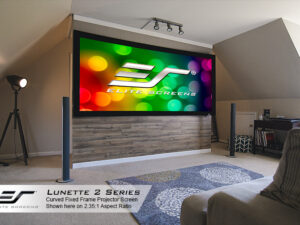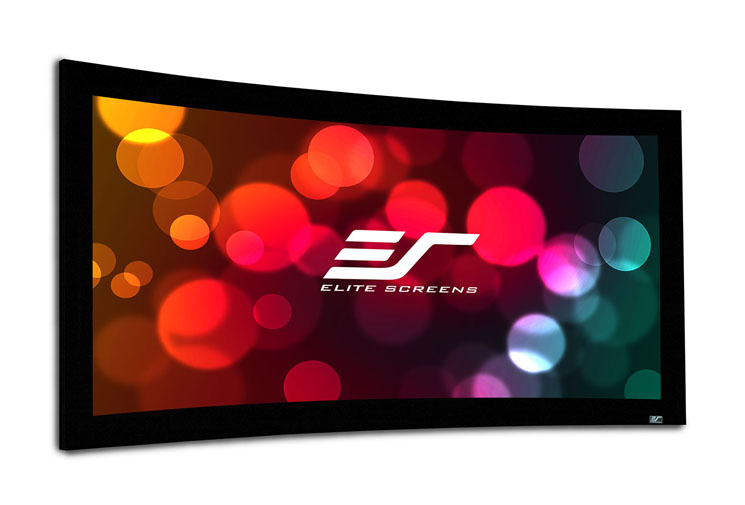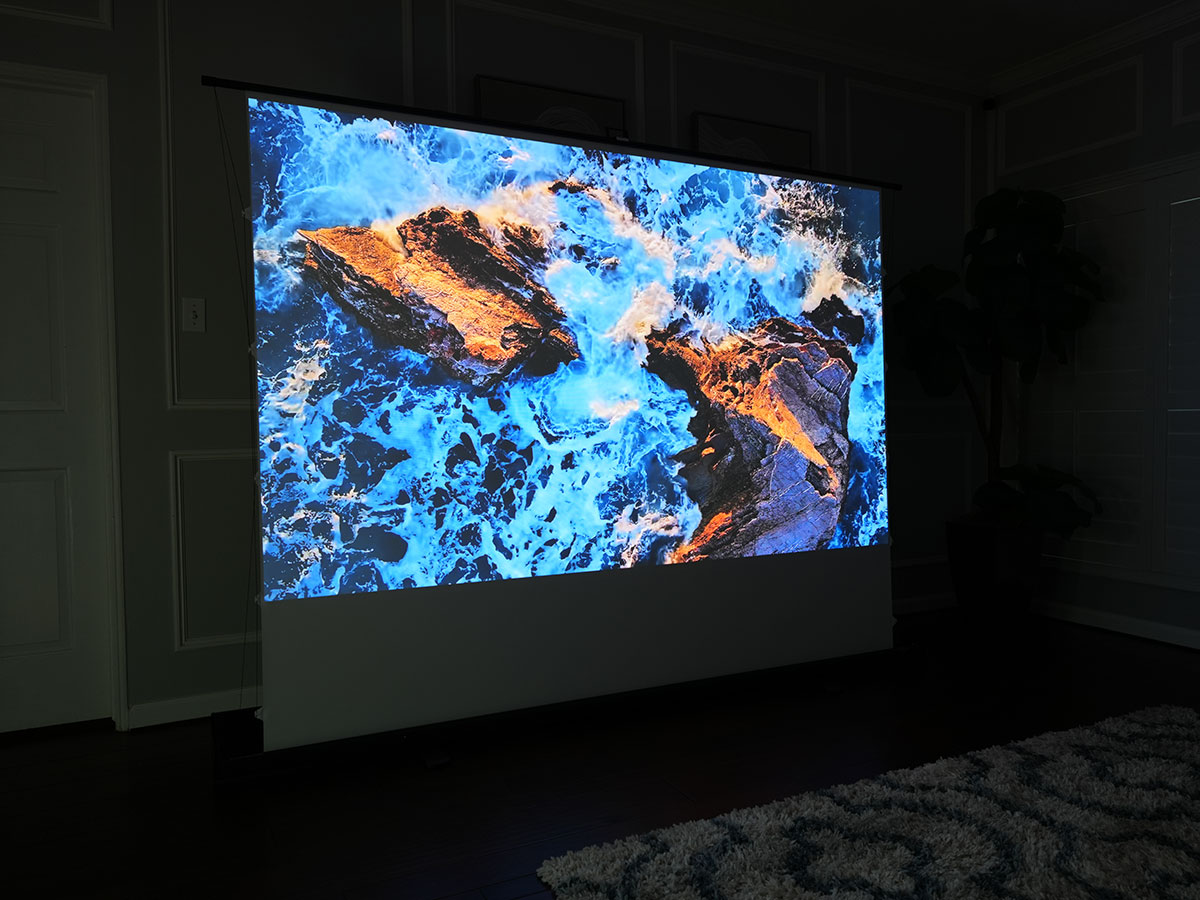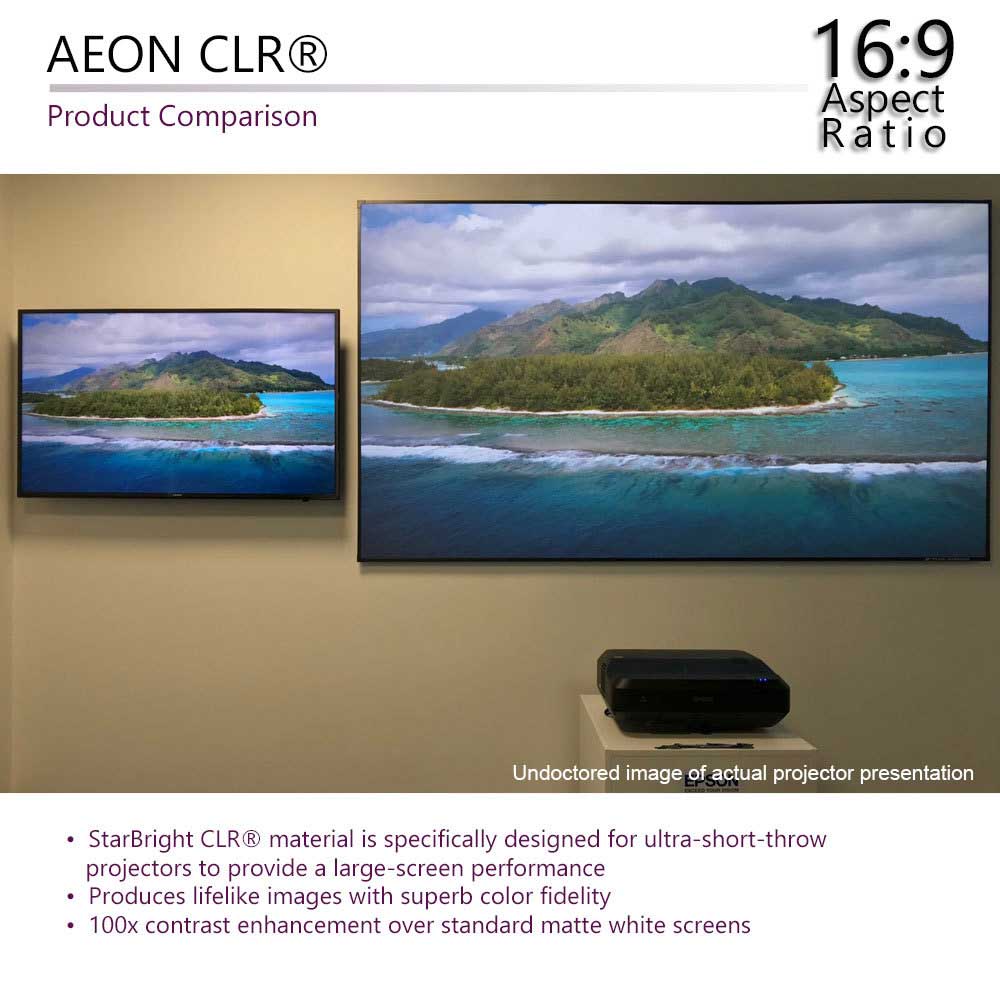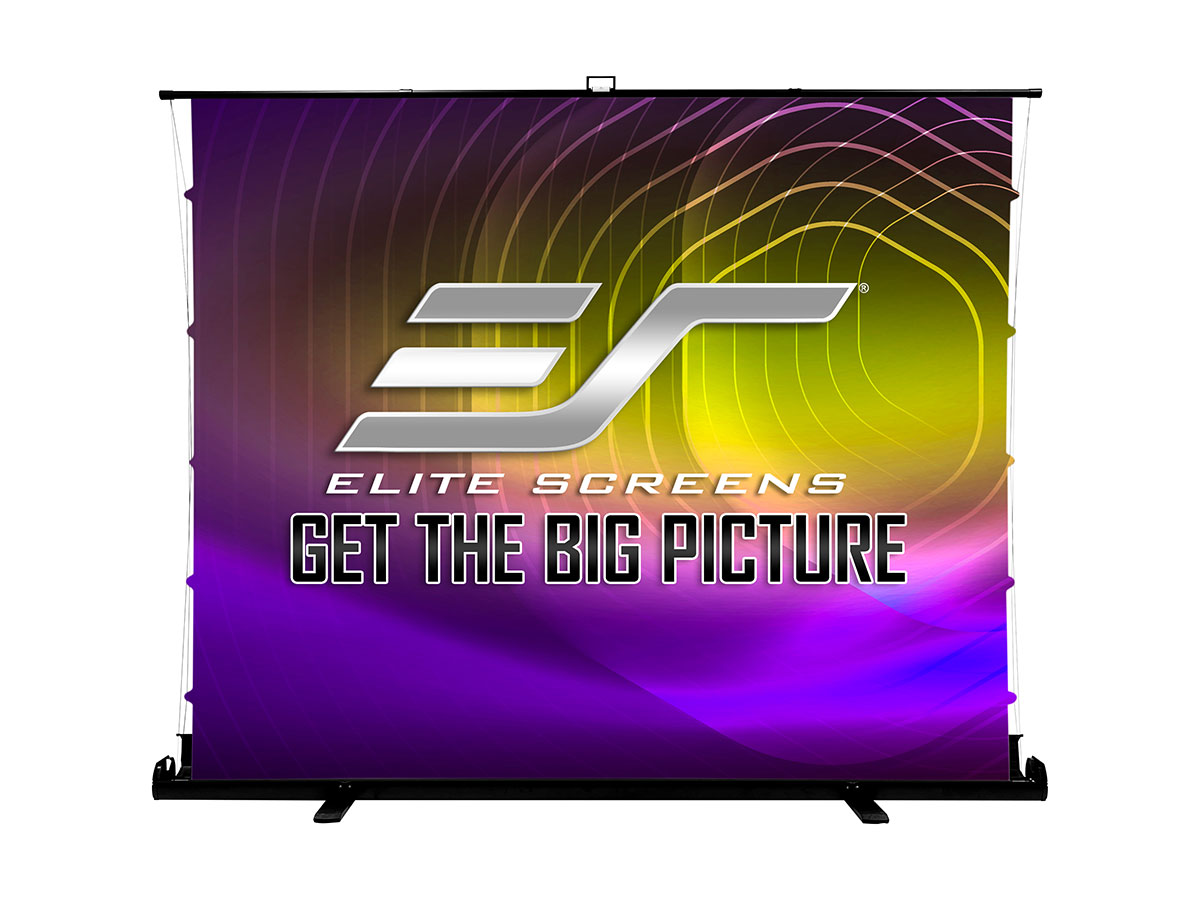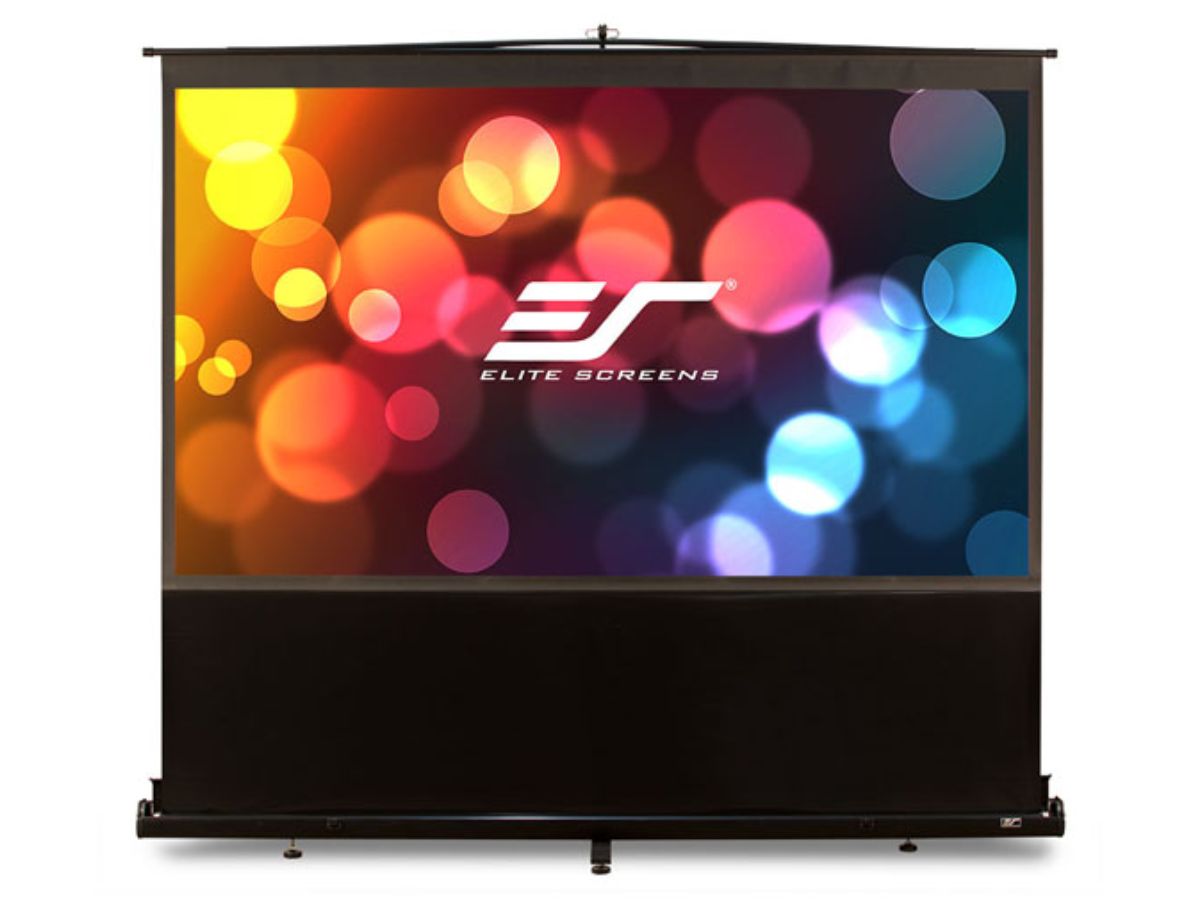Elite Screens’ EPV® Lunette AcousticPro 4K – 2.35:1 aspect ratio screen by ANDREW ROBINSON
Lately I’ve been a bit outspoken about aspect ratios and the format most commonly referred to as anamorphic or 2.35:1. While many of my recent comments have been viewed as “attacks” against the aspect ratio or format, I insist they’re anything but. But in order to better understand maybe it’s best if I start at the beginning.
2.35:1 is in reference to an aspect ratio that has become popular among filmmakers the world over for its wider than 16:9 (or 1.85:1) field of view. This aspect ratio is achieved through the use of special lenses called anamorphic lenses. Anamorphic lenses optically “squeeze” a wider field of view onto a standard frame -be it film or digital. That image then needs to be “un-squeezed,” which can be accomplished in a variety of ways, both optically as well as digitally. By the time an anamorphic film reaches Blu-ray it has been “un-squeezed” from its original state so as to appear “normal.” This “normal” appearance is most readily identified by the presence of black bars top and bottom of your screen when using a 16:9 display or projector. Now, purists will contend that in order to uphold the director’s original intent you must view said 2.35:1 content via a 2.35:1 aspect ratio screen -preferably with an anamorphic lens attachment.
In recent years there have been a number of projectors that have come out with a feature commonly referred to as lens memory. Lens memory allows for the viewer to zoom their projector’s image out so that the black bars top and bottom fall outside of the screen’s viewable surface area. In technical speak you’re essentially over scanning the image. Purists contend that over scanning, or using lens memory, results in less light output at the screen versus using an anamorphic lens attachment. Regardless of which argument you chose to believe the fact still remains that if you’re a fan of anamorphic films, then you’re going to want to get yourself a 2.35:1 aspect ratio screen.
Enter the Lunette AcousticPro 4K Series of 2.35:1 screens from Elite Screens.
The Lunette AcousticPro 4K Series (Lunette) screen falls under Elite’s custom installer line dubbed EPV® or Elite Prime Vision®. The Lunette in its 2.35:1 aspect ratio or configuration can be had in a variety of sizes ranging from 96 inches to 230 inches diagonally. The 115-inch model reviewed here carries with it a retail price of $3,156. The Lunette features a 3.5 inch aluminum frame that is wrapped in black Velvet. The Lunette’s frame features a subtle curve across its top and bottom supports; this is done to combat the pincushion effect associated with projected anamorphic images as well as improve light uniformity across the surface of the screen. Getting back to the pincushion effect for a moment, the term is used to describe the slight “pinch” that occurs towards the center of a projected 2.35:1 image -picture an hourglass lying on its side. The effect is very subtle, in truth many don’t even realize it’s there, however the Lunette’s curved frame is designed to eliminate the pincushion effect’s “negative” impact on your viewing experience. As for the light uniformity, it is said that a slight curve helps focus or “trap” the projected light inward opposed to simply reflecting it outward as is the case with flat 16:9 or 2.35:1 screens. This may be true of really large 2.35:1 screens, but I’m not certain at sizes typically found in a home environment.
The screen itself ships in several pieces; four aluminum frame pieces, the screen and backing material, a center support and four small tension rods. The tension rods keep the screen material taut while small push-pin style tabs are used to secure it in place once the four frame pieces have been assembled. The AcousticPro 4K material itself is acoustically transparent and consists of a finely woven material that is made here in the US. The reason for acoustically transparent material is so that the customer can place their chosen loudspeakers behind the screen itself, thus better recreating a true cinema experience in the home. The AcousticPro 4K material’s weave is so fine that it should not negatively impact projected images up to 4K in resolution. The black backing material helps curb light loss associated with acoustically transparent material without negatively impacting the sound. The AcousticPro 4K material itself has a reported gain of 1.0 to 1.1 depending on your viewing angle.
Application
The good folks of Elite Screens dropped by in order to help me assemble and install the Lunette in my reference theater. I’ve built Elite Screens in the past solo and have to say the process is easy enough to be completed without having to call in the pros. Still, if they’re going to offer “free” help in assembling and hanging a screen as large as mine who am I to argue?
My review Lunette was their 115-inch model, meaning it had a diagonal measurement of 115 inches or 9.6 feet. Its overall dimensions were 112.9 inches wide by 56 inches tall and 3.3 inches deep -depth calculated from the farthest edges back to the wall. Elite doesn’t list a weight for the screen but if I had to guess I’d say my review sample fell somewhere in the vicinity of 20 pounds.
Building the Lunette was easy enough, first we assembled the frame, then we stretched the rolled AcousticPro 4K material over the back and with the help of the thin plastic tension rods stretched into position. Once stretched over the frame, small plastic tabs were used to more securely hold the screen material in place. With four people lending a hand the screen went together in a matter of minutes, though solo I clocked my time at around 30. I’ve built a few screens in my day so your time(s) may vary. Once built it was time to hang the screen upon my false wall, which required me (okay Elite) to install three brackets (included); one that sits flush mounted in the center and two adjustable mounts that hold the screen’s outer, most curved edges. No brackets are required for the bottom as it just rests upon your wall or other horizontal support.
Once mounted the good folks of Elite Screens took off leaving me to enjoy the Lunette solo. I had a Panamorph UH480 on hand to use in conjunction with the Lunette screen, which I attached to my SIM2 M.150 via a custom, but temporary, mount that I devised. I also went ahead and tried the Lunette without an anamorphic lens by simply zooming my SIM2 M.150 image out until the black bars top and bottom fell off the upper and bottom edges of the screen.
Behind the screen rested the front three speakers of my Tekton Design’s Pendragon Theater, allowing me to test the Lunette’s AcousticPro 4K material’s acoustic transparency. The rest of my setup consisted of the following components; Integra DHC 80.2 AV preamp, Dune-HD Max media player, Parasound Halo A 21 and A 31 amplifiers, RBH SX-1212P/R subwoofer. All cabling, audio or video, came by way of Monoprice and all content used in this review of HD quality.
Personal Impressions
First things first, I wanted to test the acoustic transparency of the Lunette’s AcousticPro 4K material. Since I don’t do full-range measurements of my loudspeakers in my room (the results would only matter to me if I did) I just wanted to test to see if there was a dramatic difference in total SPL from my speakers with and without the screen in place. I began by level matching my front three speakers to 75dB without the screen present. Then I hung the screen in front of my three Pendragon fronts, sending a test tone to each again and re-measuring. The results were not that different, in fact my Radio Shack SPL meter couldn’t settle on an exact reading for very long, instead it seemed to fluctuate between 74 and 75dB. Worst case scenario the Lunette’s AcousticPro 4K material, in my room, resulted in a 1-2dB drop in output, but this is easily overcome by simply re-leveling your speakers to 75dB once the screen is in place. In other words it’s a non-issue and the AcousticPro 4K material is, in fact, acoustically transparent. If I saw a change in the 3-5dB range than maybe there would be some (emphasis on some) cause for concern, but 1, maybe 2dB, is a non-issue. Moreover in my subjective listening tests with and without the screen, my speakers’ overall sound and sound quality didn’t change.
Now, with any acoustically transparent screen, woven or perforated, you have to be prepared to give up a little bit of light due to the screen’s non-solid surface. Meaning light is going to penetrate through the screen itself thus resulting in a slightly lower light level when compared to non-acoustically transparent screens. I pitted the AcousticPro 4K material against Elite’s own non-acoustically transparent 1.1 gain surface and found there to be a slight drop in measurable light, but nothing too dramatic. I measured a 2 to 2.5 foot Lambert difference between the AcousticPro 4K material and Elite’s own, non-acoustically transparent 1.1 gain material. Yes the AcousticPro 4K material isn’t as bright, but it is expected as no woven or perforated screen is as bright as its non-acoustically transparent counterparts.
Once I was done fidgeting with the hard data it was time to simply enjoy the Lunette for what it was. Whether I used the Panamorph UH480 lens or simply zoomed my SIM2 M.150′s image out made no never mind to the Lunette, which is a good thing. Like I said earlier, whether you believe in having an anamorphic lens or simply wish to rely on lens memory, you still will want a 2.35:1 screen for the best anamorphic viewing experience. However, in truth, I did the majority of my viewing with my projector’s image zoomed out and the top and bottom bars simply being over scanned. The Lunette’s claims of eliminating the subtle pincushion effect associated with wide, anamorphic viewing proved true, as the subtle curved did trace the edge of the image’s frame almost perfectly. I found the image itself to be uniform in brightness, side to side and top to bottom -despite the slight light loss due to the screen material’s woven DNA.
Some have accused Elite’s AcousticPro 4K material as causing for a blue shift. Okay, however when calibrating your projector the resulting process takes into consideration the screen’s proclivities too. Did I notice a dramatic blue shift to the images projected upon the Lunette’s screen surface? Not exactly, but if one was present it would be handily dealt with in the calibration of your projector; much like the slight drop in overall SPL, it’s a non-issue.
In truth the biggest issue I had or could see with the Lunette 2.35:1 screen long term would be its non-anamorphic performance. Having a fixed screen like the Lunette means exactly that -it’s fixed. The Lunette’s 2.35:1 aspect ratio and cinema like curve is all well and good -okay great -when viewing anamorphic content, though when the images shift to 16:9 you’re going to be treated to the return of black bars, only this time they’re going to be on the side. Remember, not all films are shot with an anamorphic lens, so inevitably you’re going to have to “suffer” a slightly smaller image; one that resides in the middle of your Lunette screen rather than spanning the entire width.
Also, if filmmakers continue to produce variable aspect ratio films, meaning films that employ both 2.35:1 and 16:9 aspect ratio in the same film, you’re somewhat doubly screwed -as no 2.35:1 screen or anamorphic projection system can accommodate those. At present there are but a handful of films that employ multiple aspect ratios, but in all fairness those that do have been among the more popular or highest grossing in recent memory, which leads me to believe the practice of using two aspect ratios isn’t going away anytime soon.
Minus that caveat, I could find no other or glaring faults with the Lunette 2.35:1 screen with AcousticPro 4K material. I even liked its slightly curved nature, though I have no other rational for my affinity other than I just think it looks cool. At 115-inches diagonally I’d be reticent to say the curve “drew me in,” but I still liked seeing it and knowing it was there. Is that rational? No. But sometimes it’s okay to be a little irrational when discussing matters of home theater or personal preference. Performance wise, the Lunette screen delivers through and through. In terms of style -okay cool points -it’s a home run.
Comparable Products
Every screen manufacturer that I’m aware of makes a 2.35:1 screen of some sort. Not all of them are curved mind you, nor do they all feature a woven material like Elite’s AcousticPro 4K, but you can find other anamorphic screens. Those that directly compete with the Lunette include Stewart Filmscreen’s Cine-W, Da-Lite’s Curved Series, Draper Curved screens and SI Screens’ CURVE. Regardless of the manufacturer or material the same pitfalls associated with having a fixed 2.35:1 aspect ratio screen will always apply.
Conclusion
Elite Screens’ Lunette AcousticPro 4K 2.35:1 aspect ratio screen is the epitome of crazy, sexy, cool. The Lunette is crazy because its fixed 2.35:1 aspect ratio isn’t suitable for all types of content. It’s sexy in that it adds a bit of “cinematic flare” to ones’ home theater. It’s cool because despite its short comings, I still really like the Lunette and will be keeping it long term. For me this means swapping out one fixed screen for another, but like I said earlier, not every decision we make when it comes to our own home theaters is always rational. If I know I’m going to be enjoying a bevy of anamorphic content then I can think of no better, or more affordable curved 2.35:1 screen that I’d rather watch them on than the Lunette AcousticPro 4K 2.35:1 screen from Elite Screens.

